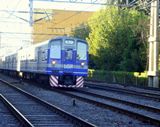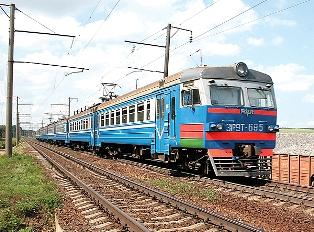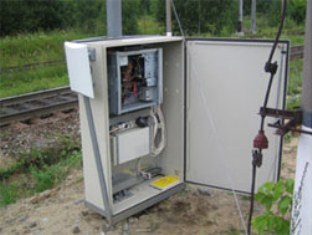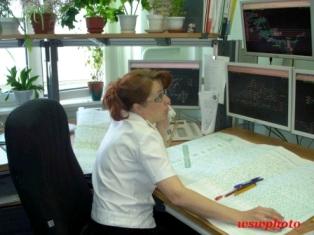Railway automation and telemechanics
 Railway automation and telemechanics deal with solving the problems of ensuring and regulating the safe movement of transport and a certain capacity of the roads thanks to the means and methods of telemechanical and automatic influence.
Railway automation and telemechanics deal with solving the problems of ensuring and regulating the safe movement of transport and a certain capacity of the roads thanks to the means and methods of telemechanical and automatic influence.
Main components of technical elements railway automation and telemechanics represented by structures and mechanisms for signaling, centralization and blocking. In turn, these devices and means are represented by track blocking, electric rail control system, centralization of arrows and signals, traffic control elements, centralization of dispatch, automatic dispatch control and fencing installations at crossings.
Usually, automation system deals with the regulation, control and management of objects in cases where there is a small distance between them.In the event that there is a significant distance between the objects, then a telemechanical system... Railway automation and telemechanics are divided into two classes: automation devices and telemechanics of the station and section.
The first group is represented by automatic blocking, locomotive automatic signaling, semi-automatic track blocking, dispatch control system and automatic crossing signaling. The second group is represented by electrical and dispatch centralization, a set of cam automation mechanisms, etc.

Travel lock settings — these are the main technical means that regulate and ensure the safety of trains after the intermediate station and section. The term track blocking means a system of automation and telemechanics elements, with the help of which such a movement is organized, in which the occupation of a certain section of the road by a train is regulated with the help of permanent signals, for example, traffic lights or semaphores.
The permission for a train to occupy a certain section of railway which is fenced with a permanent signal is determined by the open (permitting) state of the permanent signal. When a certain section of track is occupied by a train, it is closed with a permanent signal that receives a closed status.
While the train is on the section of the railway, the possibility of opening a permanent signal that protects this section of the track is excluded due to the closing installations of the track blocking. These elements block (electrically and mechanically) a permanent signal in the closed state until information is received that the train has cleared the protected section of the track.
A permanent signal receives such information automatically due to the influence of the train on the mechanisms that control the movement of the train along a certain section of the track. Thus, each fenced track section can have only one train.
Such automation and telemechanics in railway transport can be semi-automatic, when the control is carried out with the participation of a person, and fully automatic, a person is not involved. These devices are used for both unidirectional and bidirectional traffic.

An electro-tooth system is used in regulating the movement of transport on tracks that have two-way traffic. The permission to occupy the section is given to those trains for which the driver has the rod of the given section. This rod is given to the driver by the officer on duty at the departing station and the officer on duty at the arriving station collects it.
Each station limiting the line is equipped with a relay that is electrically connected to each other. Two stills belonging to one distillation have an even number of rods, as a rule, from 20 to 30, while removal of the rod from the still is possible only with an even number in two stills.
The duty officer on arrival, on receiving the baton, sends an electric current to the apparatus at the departing station by turning the indicator handle. Thus the occupation of the train is allowed. The rod system completely precludes the possibility of sending two trains at the same time. Lines with heavy traffic are equipped with automatic blocking.
The main technical elements of regulating and creating safe movement of trains that move within the stations are centralization devices for signals and switches... With their help, signals and arrows are controlled from one point (after centralization).
Depending on the energy that is used to translate the arrows, there is a mechanical centralization that uses the muscle power of a person to translate signals and arrows. There is also mechanical blocking, where hydraulic or electropneumatic drives are used. There is also an electric interlock with electric drives and corresponding circuits.
Railway hump automation and telemechanics have technical elements that can increase hump handling skills. These means are represented by devices for regulating the speed of rolling of cars and devices for automatic centralization of keys.
It is possible to supplement these means with devices that automatically set the speed of dissolution of trains, and also act together with automatic remote control elements cam locomotive.
An automatic setup is presented:
• Devices that automatically regulate the movement of vehicles within the same zone — automatic dispatcher;
• Devices that automatically adjust the modes of movement of each train according to the schedule - motorist;
• Devices that provide automatic reduction of transport speed when approaching an obstacle — safety automation.
All modern safety automation interacts with automatic locomotive signaling devices that automatically transmit information to the locomotive control cab that corresponds to directional signs or about the condition of the upcoming section of track. Automatic locomotive signaling combined with safety automation is called automatic signal tuning.
V dispatch centralization includes electrical interlocking devices and automatic interlocking. Dispatching centralization controls the signals and arrows at individual points of the railway section at the train dispatcher, and the regulation of the movement of the train on the tracks is carried out by automatic blocking.
Dispatch control of train movement is represented by a system that automatically supplies the regional train dispatcher with information about the movement of transport in the site, about the indication of traffic lights and the condition of the intermediate tracks at the stations. A light board has been installed in the control room, which reflects the location of the trains and the status of the traffic lights.
Fence elements of railway crossings are represented by a set of devices and equipment that are installed at the intersection of roads and railways at the same level. These devices are capable of automatically controlling a moving train while prohibiting the movement of vehicles through the crossing when the train is approaching.
Automation and telemechanics in transport increases the capacity of stations and traffic safety, and also contributes to better use of rolling stock.The automation of telemechanics and communications makes it possible to achieve high transport productivity.
Regarding the research work aimed at the further development of railway automation and telemechanics, relevant work is presented in the field of optical signaling, interval traffic regulation. And the field of economic effect of the use of automation devices and telemechanics in various working conditions is also widely developed.

